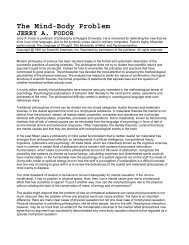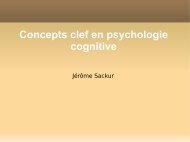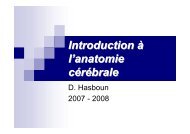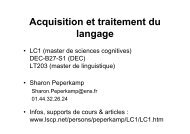From single to multiple deficit models of developmental disorders
From single to multiple deficit models of developmental disorders
From single to multiple deficit models of developmental disorders
You also want an ePaper? Increase the reach of your titles
YUMPU automatically turns print PDFs into web optimized ePapers that Google loves.
398 B.F. Penning<strong>to</strong>n / Cognition 101 (2006) 385–413<br />
subtypes <strong>of</strong> SSD, although its severity varied in an additive fashion as a function <strong>of</strong><br />
each subtype dimension. Those with SLI had a worse PA deWcit than those without<br />
SLI; those with persistent speech problems had a worse PA deWcit that those whose<br />
speech had normalized. A similar pattern <strong>of</strong> results was found for alphabet knowledge.<br />
Intriguingly, the SSD group as a whole had a less pronounced deWcit in rapid<br />
serial naming than in PA or alphabet knowledge. So the results <strong>of</strong> this study, along<br />
with other evidence reviewed earlier, indicate that there appears <strong>to</strong> be a shared underlying<br />
phonological deWcit in SSD and RD, and that this shared deWcit is found in all<br />
four subtypes <strong>of</strong> SSD. However, it always possible that the subtypes performed<br />
poorly on the PA measures for diVerent reasons. Otherwise the results <strong>of</strong> this second<br />
test reject the synergy, assortment, and pleiotropy hypotheses and only partially support<br />
the severity hypothesis, which requires a fairly common subtype <strong>of</strong> SSD (those<br />
without later RD) with a diVerent cognitive deWcit. The fact that the PA deWcit is not<br />
restricted <strong>to</strong> the group with both SSD and SLI is also inconsistent with the predictions<br />
<strong>of</strong> the synergy hypothesis, which is also contradicted by the genetic results just<br />
discussed.<br />
To address the third question regarding assortative mating, we examined the parents<br />
in our large sample <strong>of</strong> children with SSD (Tunick, Boada, Raitano, & Penning<strong>to</strong>n,<br />
submitted). Relative <strong>to</strong> control parents, parents <strong>of</strong> SSD probands reported<br />
higher rates <strong>of</strong> both speech and reading problems, indicating that SSD was familial in<br />
this sample and that SSD and RD were co-familial. We also found similar results in<br />
the siblings <strong>of</strong> probands; they had higher rates <strong>of</strong> speech problems and worse scores<br />
on preliteracy measures than controls. These results indicate an etiological overlap<br />
between SSD and RD, consistent with the studies discussed earlier. In contrast, we<br />
found low rates <strong>of</strong> cross-assortment in these parents. Moreover, SSD probands with<br />
comorbid preliteracy problems rarely came from cross-assorted parents. So we did<br />
not Wnd support for the assortment hypothesis.<br />
In sum the results <strong>of</strong> these three tests reject all but the severity hypothesis. But<br />
despite the fact that the severity hypothesis garners some support from these data<br />
and that <strong>of</strong> previous studies reviewed earlier, there are still signiWcant challenges <strong>to</strong><br />
how it accounts for the nature <strong>of</strong> the comorbidity between SSD and RD. The<br />
severity hypothesis proposes that SSD and RD are comorbid because they share<br />
etiological risk fac<strong>to</strong>rs (some <strong>of</strong> which are genetic) and these lead <strong>to</strong> a shared phonological<br />
deWcit, which is more severe in children with comorbid SSD and RD than<br />
children with RD only. To account for SSD children who do not become RD, the<br />
severity hypothesis must postulate a subtype <strong>of</strong> SSD with a distinct etiology and a<br />
diVerent underlying cognitive deWcit. If SSD children without later RD nonetheless<br />
have the same underlying phonological deWcit, the severity hypothesis must be seriously<br />
questioned. But the results <strong>of</strong> Raitano et al. (2004) just discussed suggest<br />
there is not a common subtype <strong>of</strong> SSD without a PA deWcit. Clearer evidence on<br />
this point is provided by long term follow-up study (Snowling et al., 2000) <strong>of</strong> SSD<br />
children initially identiWed by Bishop at preschool age. These researchers found<br />
there were former SSD children with a persistent deWcit in PA in adolescence who<br />
are nonetheless normal readers. Both these results are inconsistent with the severity<br />
hypothesis.







